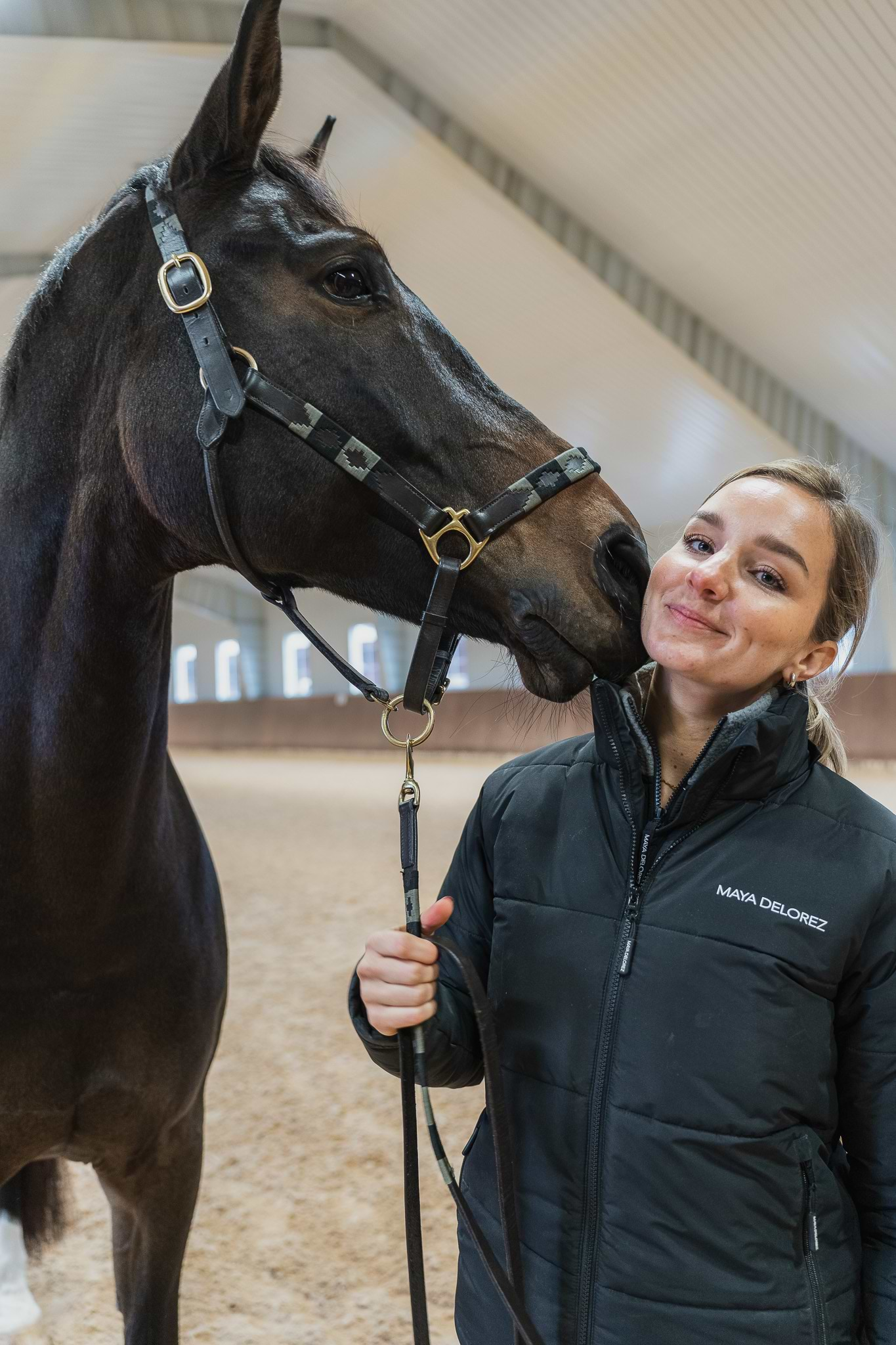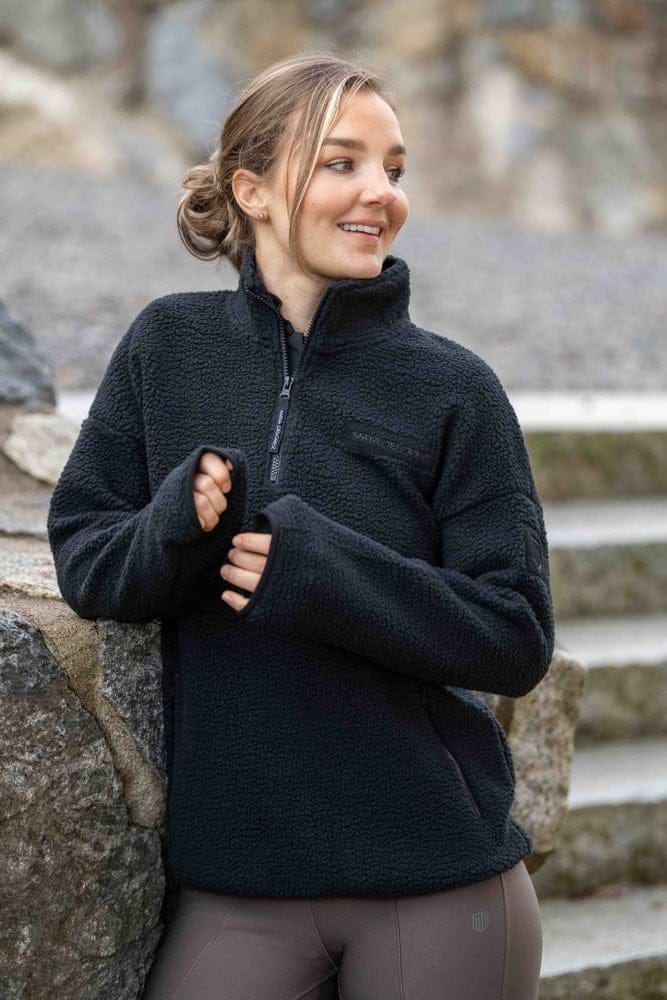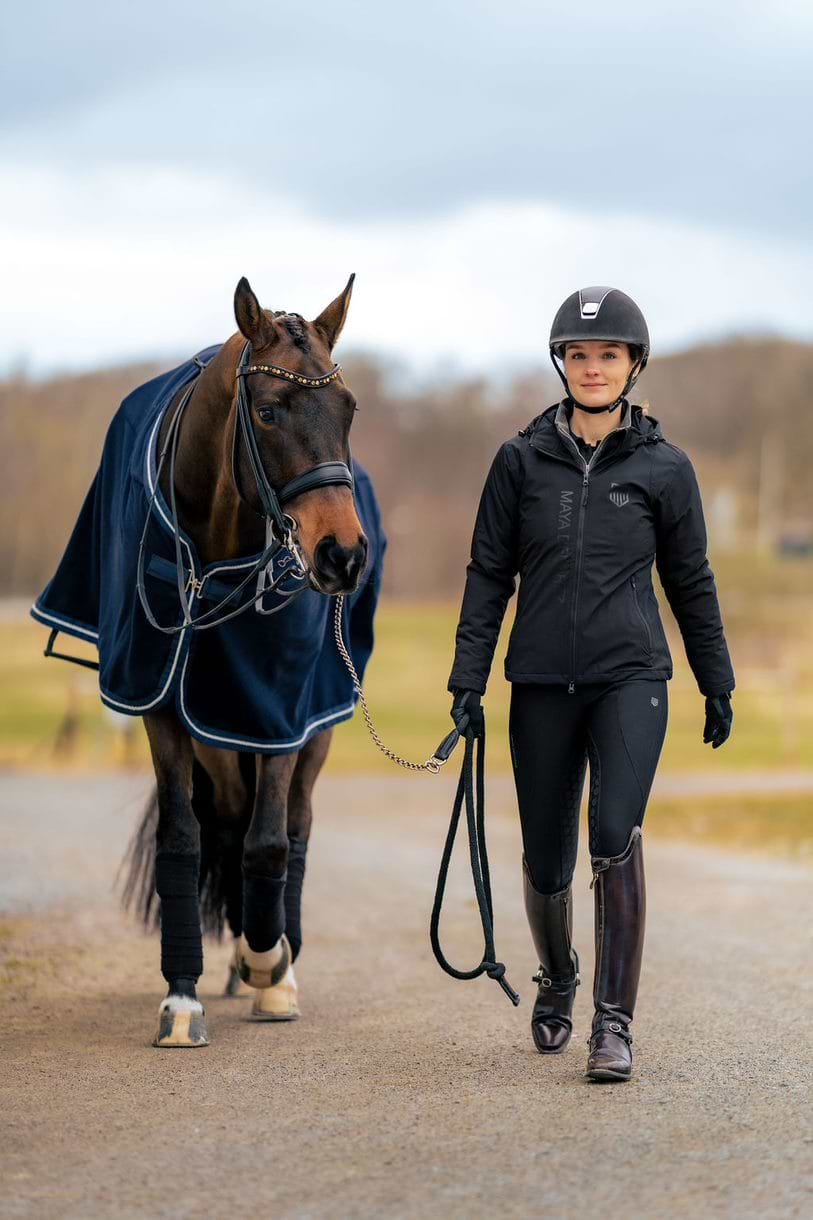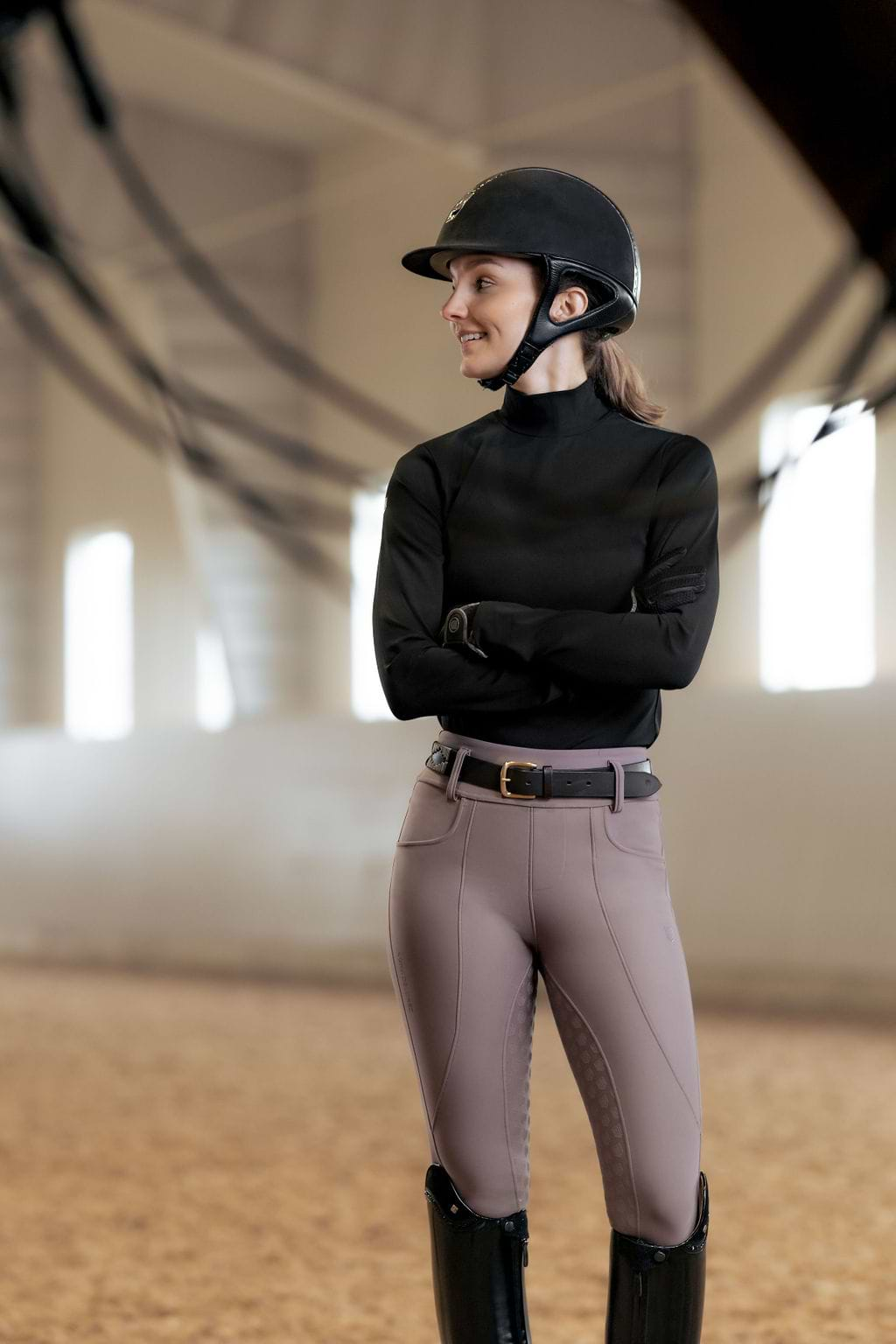Get to Know
Nina Rademaekers
Read our interview with Nina Rademaekers and learn about how her riding career started, her future prospect Melvin, her social media success – and much more.
Amanda
Tue 4 May - 21

Get to Know
Nina Rademaekers
Read our interview with Nina Rademaekers and learn about how her riding career started, her future prospect Melvin, her social media success – and much more.
Amanda
Tue 4 May - 21
Nina, who is also known as Ninas Rader, is a true multitasking talent. At an early age, she made the Swedish national pony team and ‘Nina Rademaekers’ became a name to be reckoned with. Since then, she has ridden in the Pony, Junior, Young Rider and U25 national teams. Alongside her dressage efforts, Nina also runs a blog, an Instagram account, a podcast, and a YouTube channel, all well-established within the equestrian world. She uses these platforms to inspire others to dare to follow their dreams – and we are definitely inspired!
How did it all start?
Nina, let’s start from the very beginning. How come you started riding?
– My mom has always been a horse girl and she had her own horse when she was younger. When I was a little, she rode at a riding school and it was fun to tag along with her and watch. I’ve always been completely obsessed and fascinated by horses. I took every chance I could to be with horses and always wanted to do pony riding if there was the opportunity. I was into it from an early age and when I was about five years old, I got to go to daytime riding camps in the summers, which then turned into riding camps with overnight stays. At the age of six or seven, I started riding at a riding school, and after that I’ve just kept going!
How long did it take from the time you started riding at riding school until you got your very own first horse?
– When I was 10, my mother had arranged for me and her to rent horses one summer, a pony for me and a horse for her. It got pretty crazy, though, because the pony we rented hadn’t been trained – but we didn’t know that. The woman we rented the horses from thought that the pony was just going to keep the big horse company and that we weren’t going to ride it. But she had also sent the saddle and the bridle, so it was all a bit strange.
Enya, as the pony was called, was thankfully very kind and we quickly became attached to her, even though she was untrained at the time. She was a Welsh cob with a light, long mane, four white socks and a big blaze – she really did look like a ‘my little pony’. We continued to rent her and when the summer was over, we sent the horse back – but extended the rental period for Enya. The idea was to rent her for one year, but when Christmas came my mum surprised me and I got Enya as a present. I wasn’t actually supposed to get a pony initially. But then we rented her, and we just clicked!
Today you are a dressage rider, but has it always been like this? When did you start to focus on dressage?
– Enya, as I had mentioned, had not been ridden when I started with her, so she was a bit of a blank slate. With her I did a bit of everything: Dressage, jumping and cross-country riding. But I soon realized that it was dressage that we were both best at and enjoyed the most. Then, after only four years, we competed at the Swedish Pony Championships together! Initially, we were not planning on competing; my mum has always been incredibly supportive of me competing but never pushy. The desire to try was something that grew out of my own will. We thought it would be fun to compete, so we gave it a go and it went well!
Your competitive career took off at a young age. Now that you look back, is there any special memory that you are particularly proud of?
– Oh, yes, I have a lot of great memories from my pony years. Both from big shows and just everyday moments. For example, with my pony José I rode in Globen Arena in Stockholm, which I enjoyed a lot. And we also took second place at Falsterbo Horse Show. But I also remember the first riding lesson where I managed to get Enya on the bit in canter. It was kind of a mind-blowing feeling and a huge goal at the time, haha!
In fall of 2019, you bought the six years old gelding Impress Me from Holland. Would you like to tell us a bit more about him? You have previously described Melvin, as he is called, as a “real Nina horse”. What does that mean?
– Melvin is a kind horse. He is so incredibly positive and friendly to everyone and everything. He also has a lot of energy, and that’s been the challenge with him. To use that energy the right way and get his focus on me – no matter what is going on around us. He always wants to work and do his best, and when I ride him, I clearly see that he’s always looking for the “right answer”. I think that’s the quality I like best, he wants to do the right thing all the time and his work ethic is truly amazing! Melvin is also a very cuddly horse, a bit like a puppy. He’s not the cocky type and if he was human, he would definitely be that kind and somewhat naive person who thinks well of everything and everyone.

The Three Most Important Qualities in a Horse According to Nina
Energy
"The horse wants to work and enjoys it."Work ethic
“The horse is positive about working and looks for the right answers in the tasks you give it. A horse has to be curious.”Honesty.
“It may be an odd word, but the horse should be attached to you and trust you. It’s a bit hard to explain, but I like soft horses that you feel a bond with. Horses that trust people.”
When you bought Melvin, he had only been to a few young horse competitions in Holland and was pretty green in his training. What would you say is important to consider when you set out to train a horse?
– First of all, I think it’s very important to personalize all training to suit the horse. But also, to keep in mind that a horse’s training is about so much more than just the dressage training scale or learning to leg-yield, do lead changes and pirouettes. There’s a lot of other things that the horse has to learn as well. For example, loading, shoeing, being in different environments – and riding with smoke machines on a photo shoot with Maya Delorez, haha! Jokes aside, but it’s important to see such things as part of the training as well. All horses pose different challenges, so I think it’s important to look at each horse and what they need to train for. Make a plan and give it some time. Both for your and the horse’s confidence, but also for your safety.
With your previous horse Dorano, you rode and competed up to international Grand Prix level. How does it feel to “take a step back” competitively and go for a younger, more inexperienced horse?
– I think it’s great! The challenge of riding an easier dressage class with Melvin feels just as big as riding an International Grand Prix with Dorano. For me, the challenge is always linked to where you stand as a team. I think it’s really nice to do the whole journey together. But of course, I’m really excited and motivated to get back to the bigger shows! Of all the horses I had, I think Melvin has the best qualities and the most potential. So, my hope is to be able to go even further with him in the end.
“I have big goals with Melvin and hope to be able to ride advanced classes and competitions in the future. But it also feels great to be able to shape him from the start.”
– Nina Rademaekers
It may be hard to answer right now with the pandemic and EHV1 outbreak, but when can we expect to see you and Melvin compete?
– Next weekend we’re doing our first show together! We will compete two days in a row in a program that is quite simple and straightforward for Melvin from a technical point of view. I don’t want the technical aspects to be the hard part of the first competition, but rather everything around it to be the focus. Just going from the warm-up area to the actual competition area will be something new for him.
What motivates you in this sport?
– When you have trained something for a long time, and then feel that the horse understands. I find that development and the bond you build with your horse very motivating. And then to look back and see how far you’ve come. That’s also why I started my blog in the first place. It’s a good way to be able to look back and see how much you’ve developed. Apart from that, I also think it’s super fun and motivating to compete!

Working with Social Media
Your full name is Nina Rademaekers – but to many, you’re Ninas Rader. Tell us, how come?
– My last name is Rademaekers, but when I was about to start my blog, I realized that no one would find it if I named it that way because it’s both difficult to spell and difficult to pronounce. So, I considered other options and thought ‘Ninas Rader’ was funny. Partly because the Swedish word ‘rader’ means ‘lines’ and on my blog, I write lines about my daily life and experiences. But also, because it’s similar to my real name. Since then, that name has just stuck! It’s quite funny, because I notice that many people on Instagram, for example, think that’s my real name.
Today, you are a prominent equestrian social media figure and in addition to your well-known blog, you also run a podcast, an Instagram account and a YouTube channel. Why do you think you’ve been so successful on social media?
– Oh, that’s a hard question. When I started my blog, I had just bought a horse called Bizet who was a bit of a project horse and quite tricky. On the blog I shared both my ups and downs, which I think many people appreciated. I didn’t just write about when things went well, but also about when we, for example, were eliminated at a competition because Bizet was rearing and such. And I noticed early on that people found it interesting to follow this and that many could identify with it. So initially, I think that’s what people found enjoyable about my social media, that I was transparent with the ups and downs. Then I also think that people maybe find it interesting to follow me as I compete at a high level but don’t work with horses the traditional way.
Nina’s Top Tips for Social Media Success
Update often. Even when I only had like five readers, I updated my blog three to four times every day. I tried to act like I already had a lot of readers, just in case one day I did.
Find your thing and what you think is interesting to share. For me it’s horses, but for someone else it might be cooking.
Be yourself. Some people try to conform and be a certain way and I think people see through that. Try to be yourself on your channels, because it will probably be very hard in the long run if you have to be someone else.
Your social media content is very unconventional and spontaneous, while at the same time you come across as a very planned and professional person who doesn’t leave anything to chance. So how much of it is strategy and how much is just feeling?
– I would say that a lot of my content is spontaneous! When it comes to collaborations and such, it depends a bit on the set-up of course. Some collaborations need to be planned a little bit more, but then I still try to make it interesting. But a lot of my content is actually things that are captured ‘in the moment’. With the podcast, for example, we don’t write a script or anything. Me and Vanessa just come up with some topics and then we take it from there. Most of it is spontaneous and that’s also when it’s best, I think.
You’ve been updating your blog ever since 2012. Now, nine years later, can you share something not many people know about you?
– I have a huge head, am 1/4 Dutch, right-handed but eat like a lefty, and have met Justin Bieber. Those are my biggest flexes, haha!
Inspiration
Equestrian-related or not, who or what inspires you?
– I don’t have a specific rider or person as a direct role model, but there are several I find inspiring. When it comes to equestrians, for example, I think Cathrine Dufour rides really well! But I’m also very inspired by people I meet every day. Sometimes I come across people where I feel like “Wow, this is a really inspiring person!” and it might be, for example, because they have a lovely personality or are inclusive and supportive of others. That’s how I want to be and how I want to be perceived, so it inspires me.
In closing, what are your top tips for young horse girls and guys out there who dream of a successful competitive career in equestrian sports?
Ride a lot – the more you ride, the better you’ll get at it. But I think it’s just as important to watch others ride and learn from them.
Try to be in an environment where you can see, and be inspired by, people who are doing what you want to do.
Ask a lot! Dare to take help from others who are further along and know more than you.
And finally, remember to have fun! My mother has always reminded me that we ride and compete to have fun. Even if it doesn’t go well results-wise, we can still have fun and make it an enjoyable weekend. Of course it’s normal to be disappointed, I know that myself. But you have to be able to step out of the competition bubble to gain some perspective on it. After all, just being at a competition with a healthy horse is in itself fantastic!
Five quick questions
Your favorite riding season?
"I would have to say spring! That’s when it’s sunny, but not too hot."
Your favorite emoji?
"Hmm… Oh, that’s a hard one! I like to use emojis that people wouldn’t expect. But I like and use the one with three hearts around its head a lot ( 🥰 ). I have a "worst emoji" too, I just think it’s awful! It’s the one with the unpleasant smile ( 🙂 ) It seems happy – though not genuinely happy, haha."
Mare or gelding?
"Gelding."
Packing hay bags or mucking out the stable?
"Mucking out the stable, because I’m allergic to hay."
Favorite dressage movement?
“If I have to choose, I’d say flying changes in sequences.”
